A sea is a place full of mystery – humankind has mapped out more outer space than we have of our own seabed.
So, it’s not really any big surprise that, from time to time, bizarre things tend to wash up on our beaches and coastlines.
From World War II relics to Ice Age and Prehistoric remains, here are 20 of the strangest things that have ever washed up on our shores.
A World War II fighter plane.
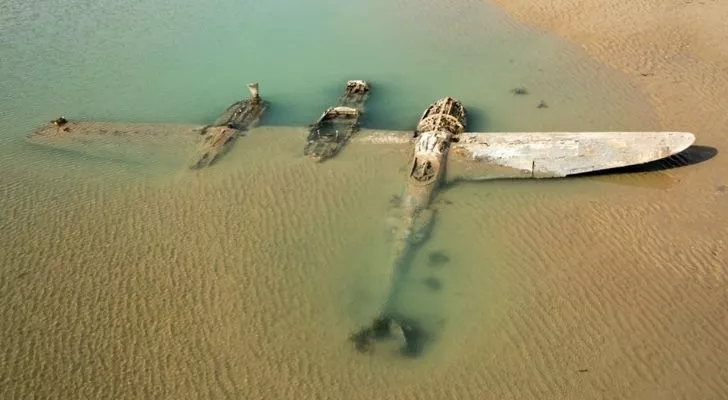
This one definitely is a weird one! Back in 2010, a USAF Lockheed P38 Lightning fighter aircraft appeared on the beaches of the Welsh Coast.
Named the Maid of Harlech, the fighter plane crashed into the Welsh sea during a training exercise in 1942.
Until 2010, it was buried beneath the waves, but the changing beachfront and seabed revealed the plane on the shore of the Gwynedd coast.
The exact location of the fighter plane has been kept a secret to ensure the wreck is preserved.
A really gigantic tree.
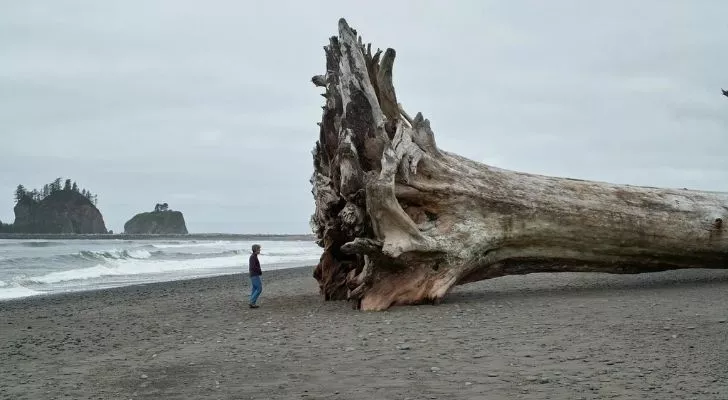
In 2010 a piece of driftwood washed up on the shore of La Push – a small coastal town on the northwest of Washington‘s westernmost peninsula.
Now, I know what you’re thinking: a piece of driftwood, what’s strange or weird about that?
Well, the piece of driftwood in question just so happened to be a full gigantic tree that was at least 10-foot-wide and a couple of hundred feet tall!
When you look at that gigantic wooden wonder, you can’t help but wonder if it might be the biggest piece of driftwood ever found.
Giant snowballs… or tiny snowmen pieces.

This one resulted from a very peculiar natural phenomenon in 2016, which caused 11 miles of the Western Siberian coast off the Gulf of Ob to be covered in huge snowballs.
It all seems very nonsensical that snowballs would just wash up on the beach from the sea.
However, it occurred due to small pieces of ice forming in the water before being rolled together into big round balls by both the wind and waves.
The snowballs ranged anywhere in size from that of a tennis ball to 3 feet wide icy boulders!
A giant die.
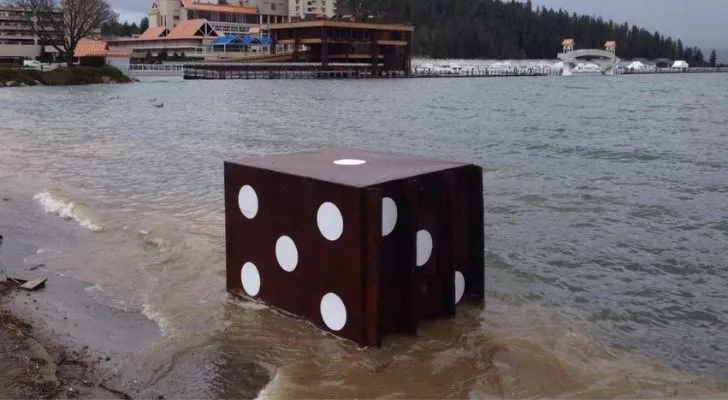
Back in 2017, locals of Coeur d’Alene in Idaho were a little puzzled to see a six-by-six-foot rusty metal die to wash up on their shores.
One side of the metal cube had pipes coming out of it and, despite its extensive rust, the white spots were immaculate.
Upon closer inspection, it seemed that somebody had put large white spots on an otherwise unremarkable service box.
Coeur d’Alene resident Sam Gridley confirmed this, who had seen the old storage tank washed up a few years back before someone had put the white spots on it.
After this, some particularly bad rainfall and flooding were enough to sweep the giant die back out into the waves to wash up again later.
A German U-Boat.
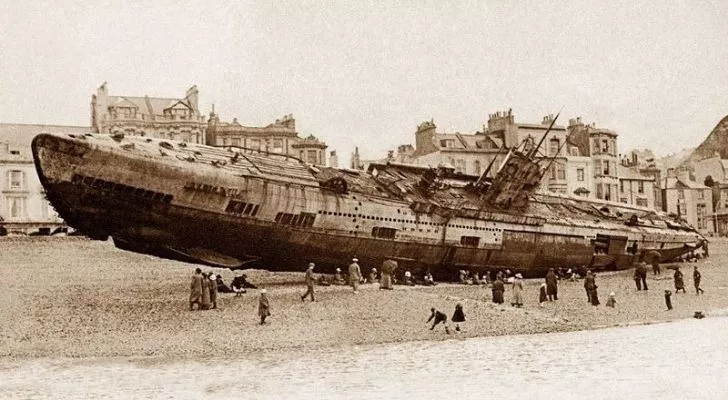
In 1919, with the First World War having recently drawn to a close, the residents of the English town Hastings woke up to a bit of a shock one morning when they found a full German U-Boat beached on their shores.
Back in these days, for most about everyone, a U-Boat was something they’d only ever heard about and never seen, so they were all pretty excited!
So much so, that the town clerk started charging people to have their picture taken on the deck!
Two coastguards even started giving important people tours on the interior, until they became very ill and died shortly after.
It’s believed that leaking chlorine gas from the U-Boat’s batteries was what caused their deaths.
So how did this weapon of war end up on the sleepy Hastings beachfront?
With the end of World War I’s hostilities, the Imperial German Navy was surrendered to the allies, including this particular U-Boat, U-118. U-118 was to be transferred to France and broken up for scrap.
However, as it was being towed through the English Channel towards Scapa Flow, stormy weather caused its tow-ropes to become broken, leaving U-118 floating about aimlessly in the sea before washing up on the Hastings coast.
A 250-year old Swivel Gun.

During an unusually low tide in 2010 at Dundee Beach, southwest of Darwin in Australia, teenager Christopher Doukas noticed a strange object poking out of the sands.
Christopher and his dad went to investigate the alien object and found it to be a 250-year old Swivel Gun.
This was a pretty big find, given that there had been no documented foreign contact with Australia until Captain Cook landed in 1770, meaning the ancient artillery pre-dated that oh-so historic encounter.
The aged canon, made of bronze, is believed to be of Indonesian origin and was lost to the seas, maybe along with its ship, where it stayed buried underneath the sands for centuries.
Whale bits… and whole whales.
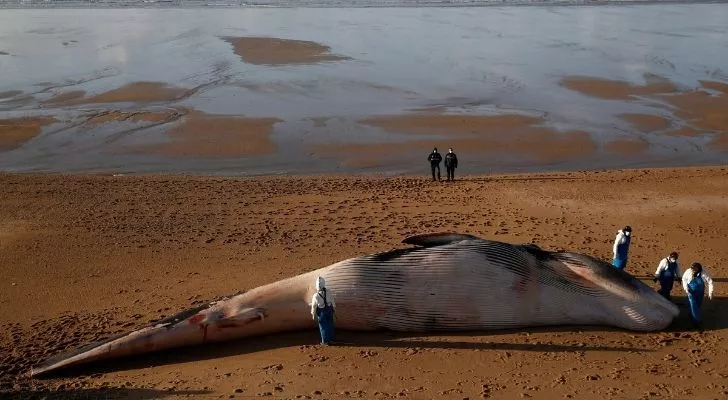
Dead sea creatures wash up daily across all of the world’s ocean-front coastlines. Despite their enormous size, whales are no exception to this as well.
From time to time, huge sections of decomposed whales will wash up.
When you look at the exposed spine of a whale sitting on a beach, it’s pretty easy to see how the people of old imagined up dragons and krakens when they saw things like this!
However, whole dead whales are also a rather strange occurrence that sometimes graces our beaches.
So how do they get rid of an entire whale on a beach before it starts stinking the place up?
Well, that’s simple: explosives. No, seriously. The country’s military will often blow the whale up to smithereens and let the next tide wash the bits back out to sea!
A message in a… melon?

Everyone’s heard of a message in a bottle washing up on shore somewhere.
In fiction, it’s often the catalyst of some very exciting adventure to find some shipwrecked explorers or pirate’s bounty, whereas, in reality, it’s usually just a little note saying “You Just Lost The Game” or something inconsequential.
However, there have been occasions where a melon has washed up on a beach that has a note stored in it.
This is really weird given that the whole reason for putting a message in a bottle in the first place is to keep it dry from the sea, but the inside of melons is wet… I’m so confused.
Gigantic Lego Minifigures.
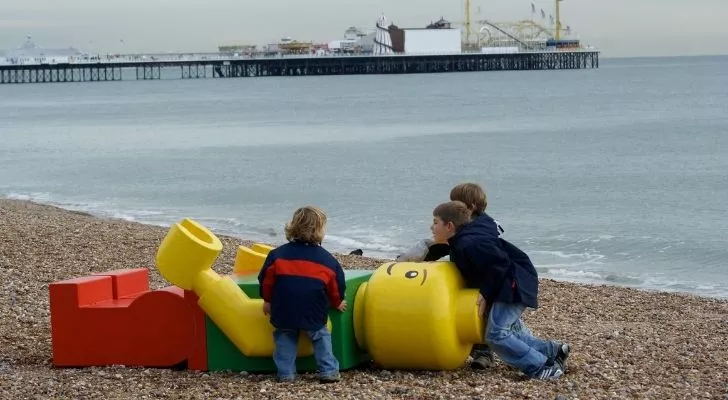
The open seas surrounding The Netherlands are one of the planet’s most popular sailing channels for container ships.
Oh, they’re also renowned for being prone to some of the world’s most stormy open sea weather.
The perfect mix for things falling overboard and washing up on the shores somewhere, wouldn’t you say?
This is what was initially believed to be behind the appearance of a thousand-pound, eight-foot Lego man washing up on the shores of Zandvoort, The Netherlands, in 2007.
However, several others appeared on other beaches over time – from Florida to Brighton – featuring the mysterious label “Ego Leonard.”
It’s not known if “Ego Leonard” is an acronym for the artist or the name of the figures.
However, there’s some weighty speculation that Dutch guerrilla-artist Leon Keer is responsible for the Lego men appearing.
However, nobody is 100% sure – all we do know is they’ve appeared randomly on the shores of beaches worldwide!
A bag of severed human hands.

A bag with 27 pairs of hands – or 54 hands, depends on how you want to look at it, washed up on the Siberian shores of the icy Amur River.
Discovered by a fisherman in the Spring of 2018, the bag of severed hands was, according to the Russian Investigative Committee, “not of criminal origin […] but were disposed of in a manner not provided for by law.”
Medical equipment, bandages, and hospital-style shoes were discovered near the hands.
Apparently, it’s not uncommon for forensic labs to hold onto hands for a while after disposing of bodies to keep hold of the fingerprint info.
But how they ended up in the Amur River is anyone’s guess.
Spielberg’s E.T.

Yes, I mean the little brown and wrinkly dude from the Spielberg film who entranced a generation of kids and scared the living hell out of child me.
In 2011, Hampshire lady Margaret Wells had her home robbed. One of the things the burglars took was a life-size E.T. that her daughter had made as part of a stage makeup course.
Fast forward a few months and a few miles to Portsmouth, and an unassuming beachgoer spotted what they initially thought was a body floating in the surf.
They called the police in a panic to report it, but when they turned up to check it out, they discovered it was none other than Margaret’s E.T.!
“There’s only one in the whole of England, and that is mine,” Margaret said. “I always knew E.T. would come home.”
Way to steal my “E.T. goes home” punchline, Margaret.
A load of human feet.

Since 2007, over a dozen human feet have washed up on the shores of the Salish Sea in British Colombia, Canada!
Neither law enforcers, researchers, scientists, nor residents have any clue where the feet are coming from – and that is scarier than the fact they’re just washing up there.
Out of the 14 feet, 12 had running shoes on, one a hiking boot, and none of them showed signs of trauma. Weird.
Ice Age bones and human Mayan remains.
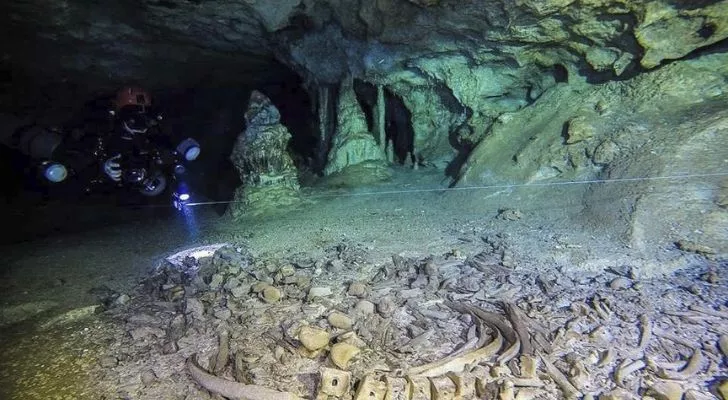
As the ice caps continue to melt, scientists are discovering more and more things that have been stored away for thousands of years.
Back in 2018, scientists were able to find a treasure trove of 9,000-year-old Mayan human remains.
They also found a bunch of Ice Age bones as they became tidally accessible in a Mexican coastal cave.
A robot hand.
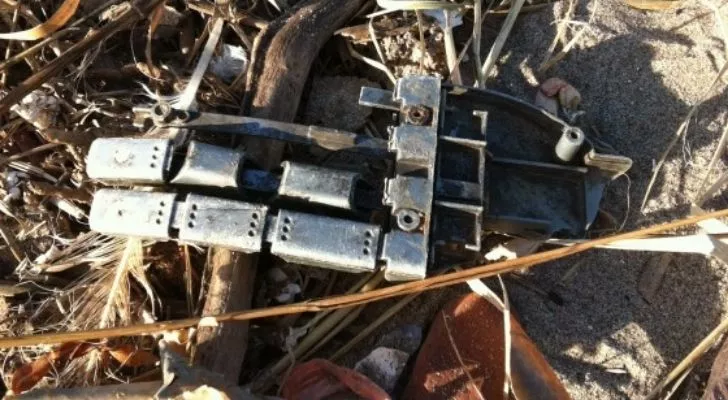
Probably not a surprise that a (robot) body part washed up on this beach, given that it is called Great Kills Park in Staten Island.
The robot hand looked a bit like the terminator’s metallic and skeletal hand, only with a couple of digits missing.
The weirdest thing about it all is how the hand was the only robot body piece to wash up.
Thousands and thousands of jellyfish.
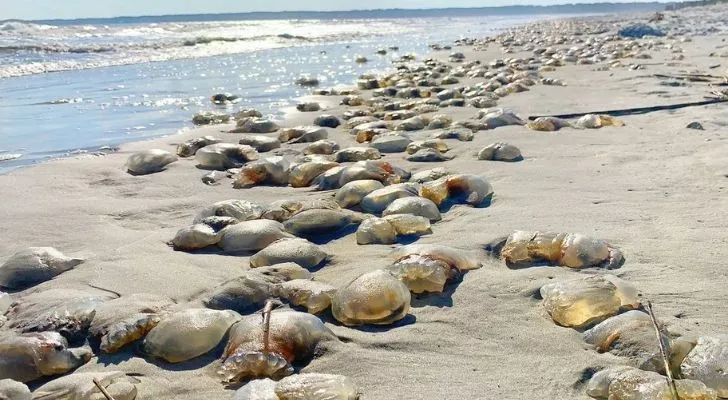
Throughout history, there have been many cases of jellyfish washing up ashore in the tens of thousands, covering miles and miles of beach.
The fact that jellyfish are so light (the smaller ones, anyway) means the wind often determines where they go.
Because of this, they can often get stranded on beaches if they are blown out and unable to wash back with the receding tides.
Despite extensive research, scientists still aren’t sure exactly how to stop it from happening.
One hundred live World War II bombs.
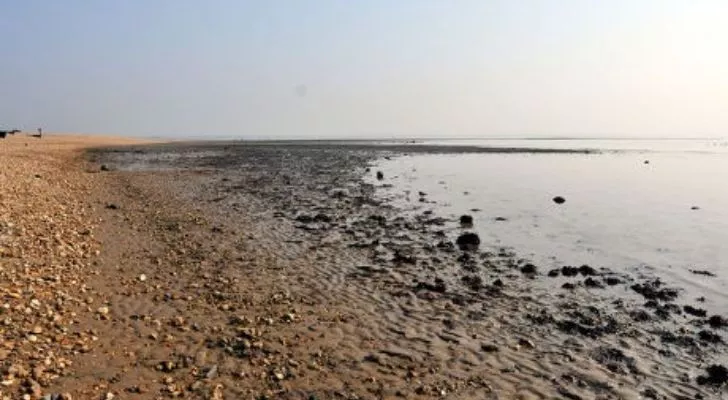
Back in 2011, residents of Calshot, Hampshire, woke up to find their beach covered in a hundred 20-inch mortar shells from World War II.
A combination of shallow tides and high atmospheric pressure caused the devices to become dislodged from below the seabed and washed up onto the beach.
The mortar shells were stacked up by a bomb disposal team from the Royal Navy’s Southern Diving Unit 2 and detonated in a controlled explosion – boy, that must have been a sight to see!
Lots and lots and lots of rubber duckies.

In 1992, a large wave knocked off several containers from a Chinese container ship which sent thousands of rubber duckies spilling into the stormy seas.
Since then, they have been washing up in large quantities worldwide – making appearances on the coasts of Hawaii, Alaska, South America, Australia, Europe, the U.K., the Pacific Northwest, and even the Arctic icecaps!
Scientists believe there are about 200 left in the North Pacific Gyre, which they are using to monitor current movements in and around the infamous Great Pacific Ocean Garbage Patch.
These cutesy little yellow fellows were even the subject of a book called, and wait for it because it’s so punny it’ll send you quackers, Moby-Duck.
A dinosaur.
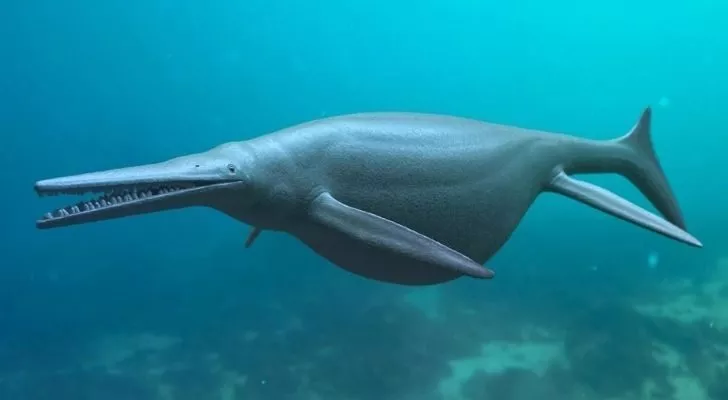
In early 2018, a large prehistoric jawbone from an Ichthyosaur washed up on the coast of Lilstock beach in Somerset, England, UK.
Up until this bone washed up, scientists believed Ichthyosaurs maxed out in length at about 69 feet.
However, when scaling up the jawbone to determine the creature’s size, they discovered the Ichthyosaur the jawbone came from would have been at least 85 feet long!
This strange find has paved the way to new scientific thinking that there were, in fact, larger types of Ichthyosaur that we may not yet be fully aware of!
So many creepy ghost ships.
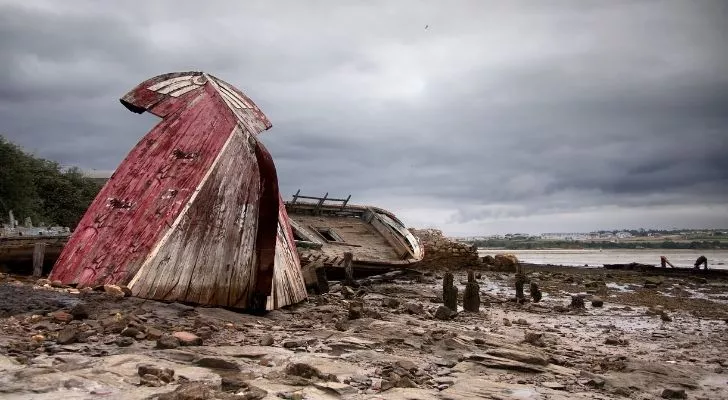
Ghost ships have captured the imagination of creepypasta fanatics since the pre-internet days of the Ourang Medan.
However, unlike the spooky campfire stories attached to them, ghost ships are a very real phenomenon. In 2016, an empty 200-foot long oil tanker just washed up on the shores of Liberia with no explanation and no crew.
Another incident occurred when a 580-foot long container ship washed up just off the shores of Myanmar after being lost at sea for almost a decade.
Whether ghosts are real or not is still open to debate – but ghost ships are a cold, hard factual occurrence!
Bananas.
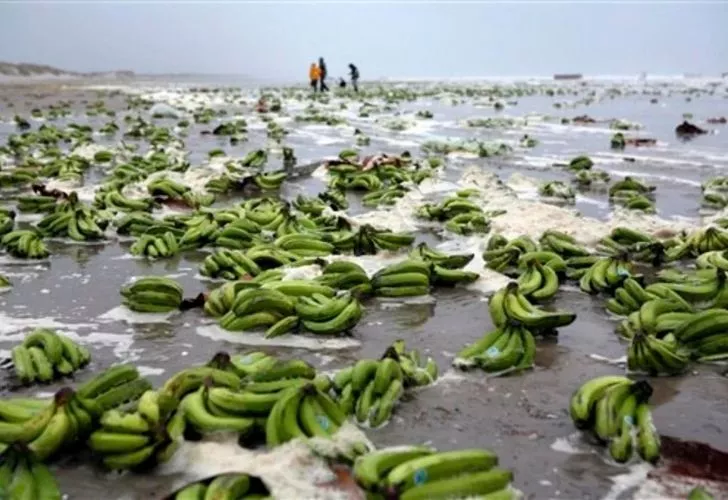
In 2007, six crates of bananas exported from Cuba were washed overboard during stormy weather.
Within days, thousands and thousands of banana bunches started to wash up on the Dutch shores of the Terschelling Island and Ameland Island.
The banana tide drew loads of people to the coasts, and some visitors even sent some of the bananas to local zoos!
And there you have it, some of the most mysterious things washed up on our shores.
From chilling ghost ships and ex-fighter planes to rubber duckies and giant lego men, can things get any weirder?
What strange stuff have you found while on by the coast?


















